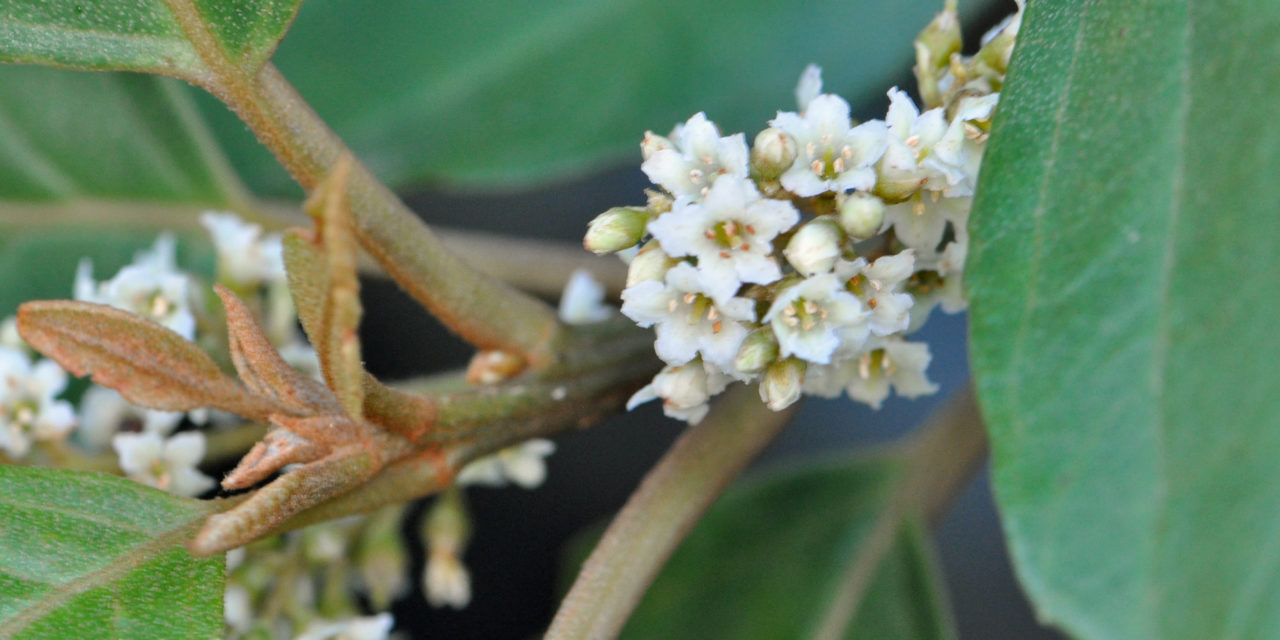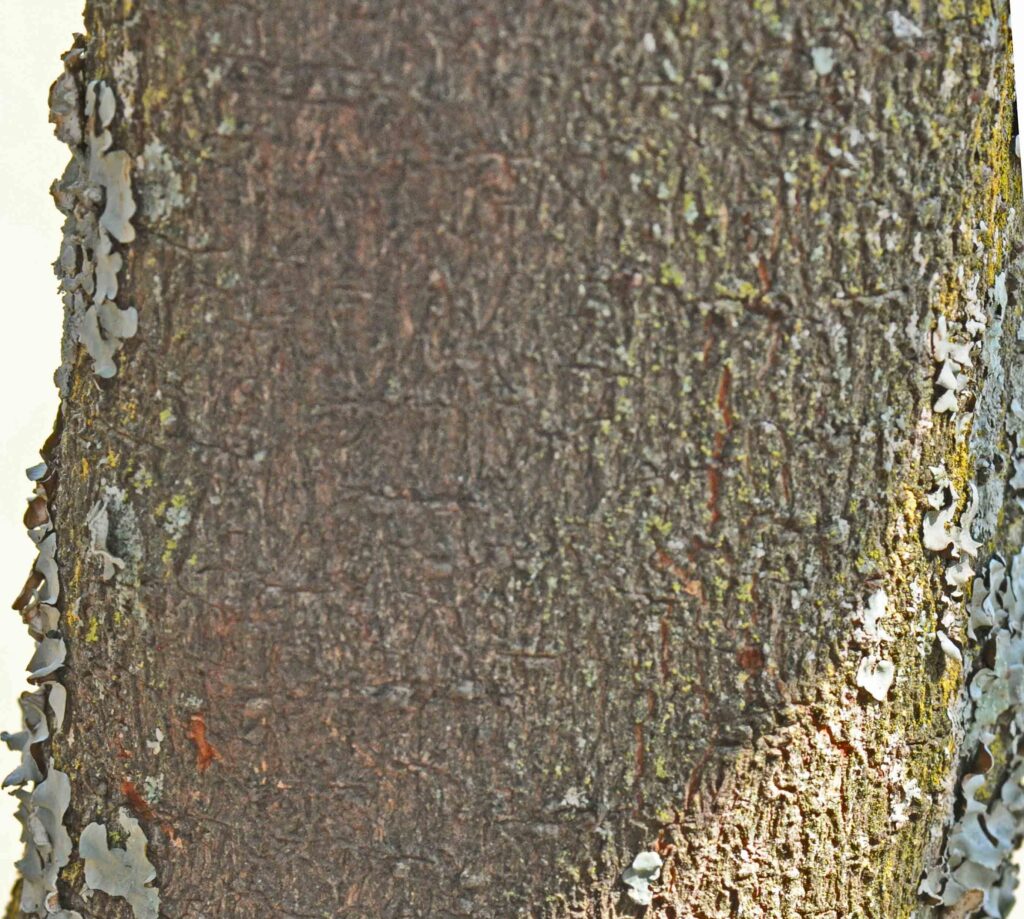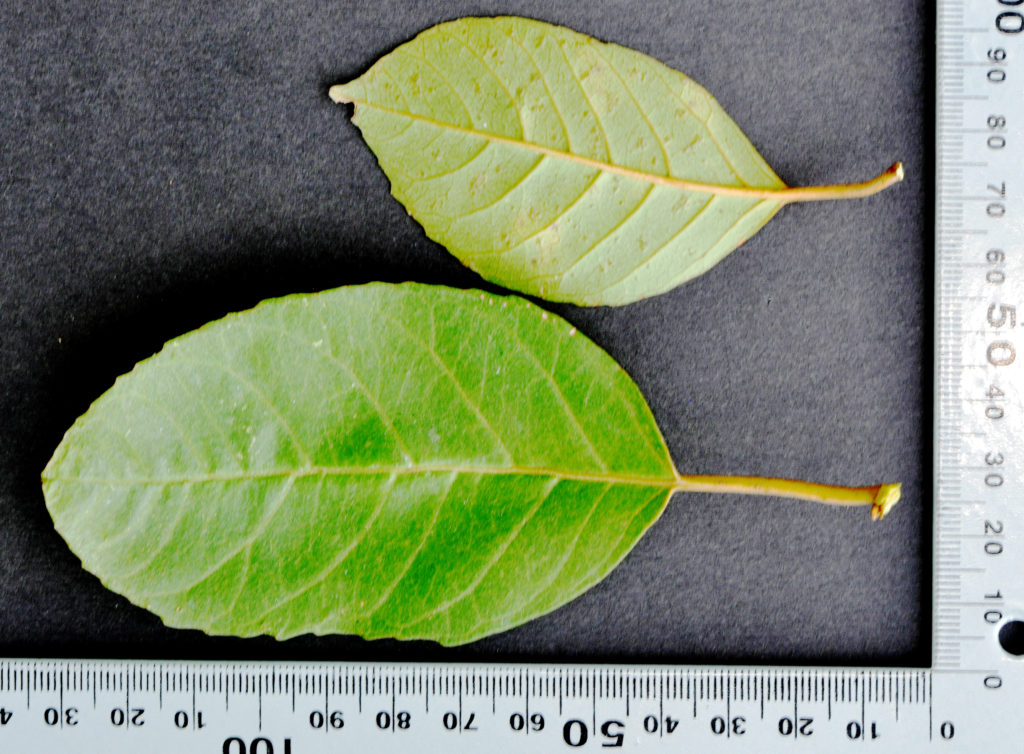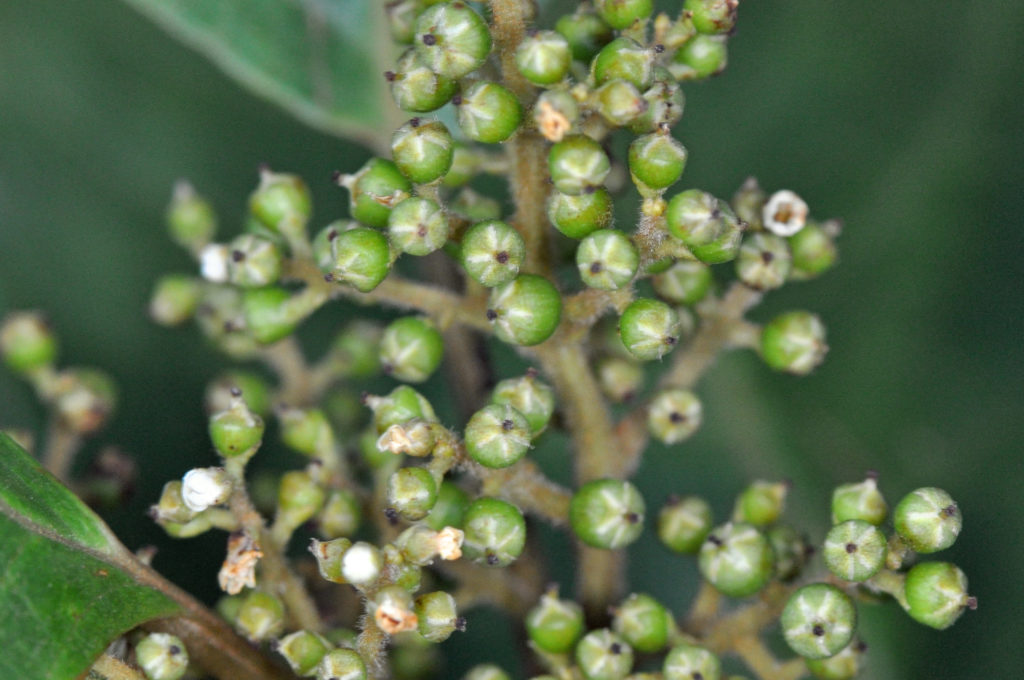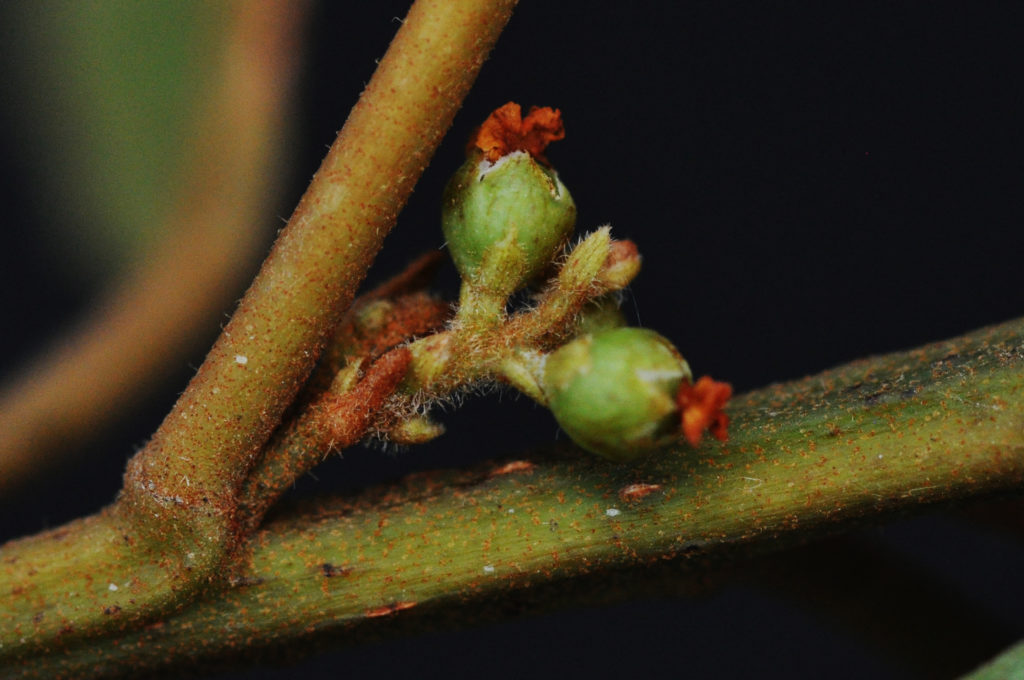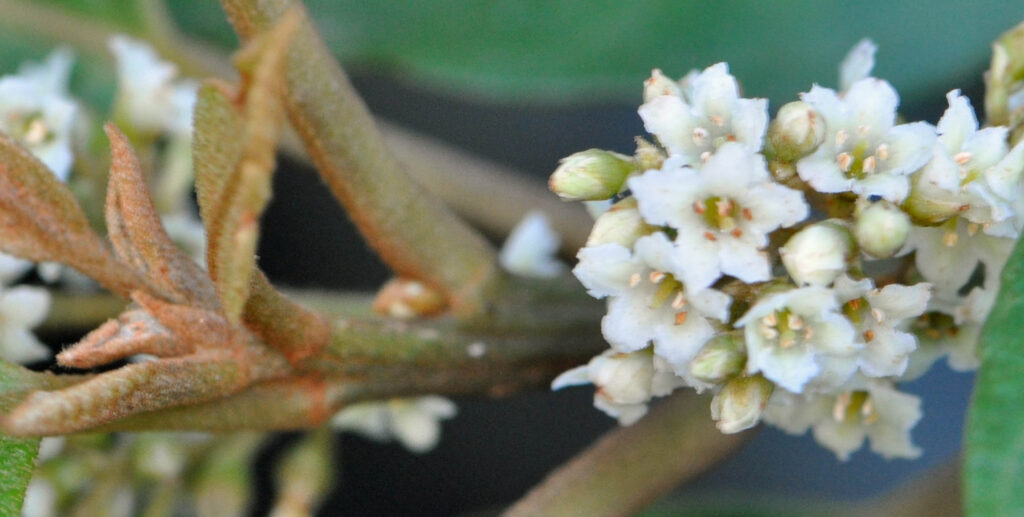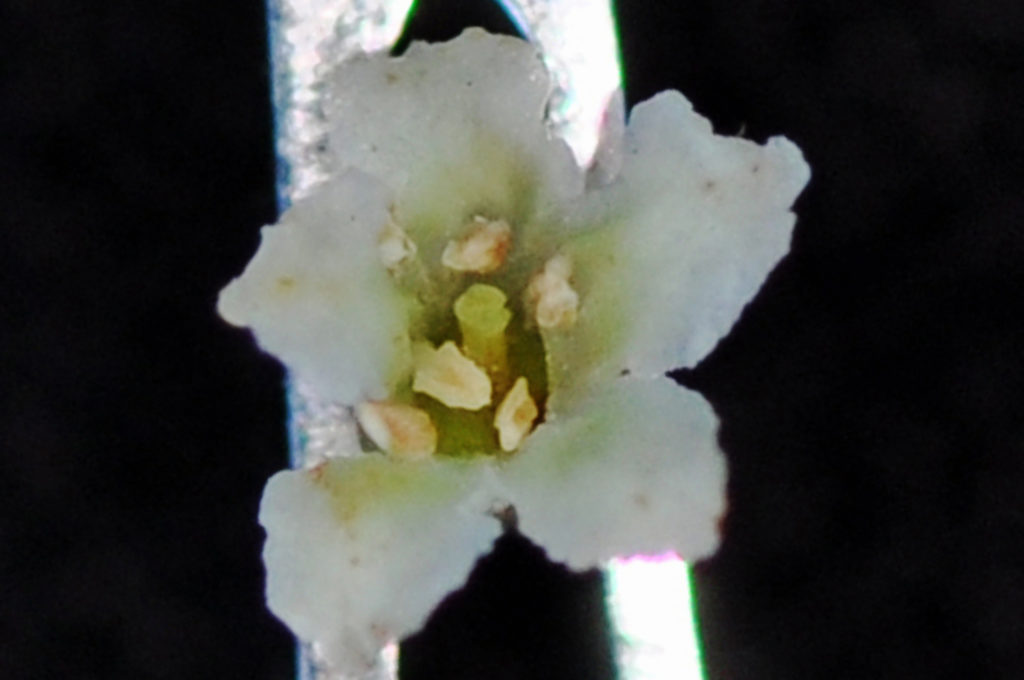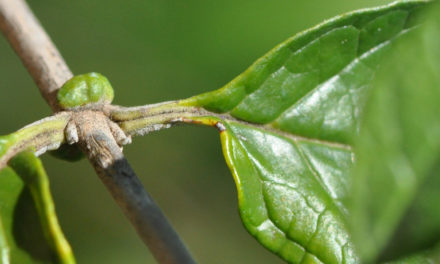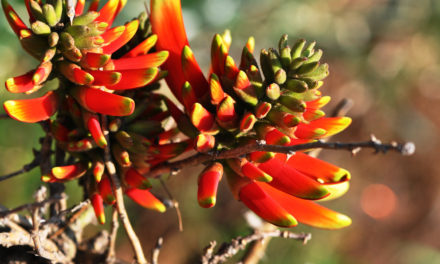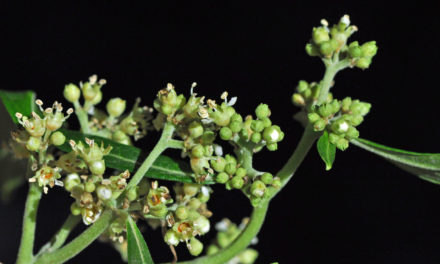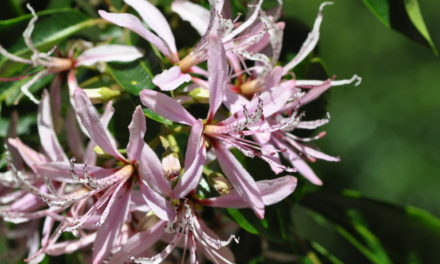General Info – summary currently upgrading.
This smallish Tree with its non-invasive roots has simple Leaves with margins that may be entire or toothed. Small, sweet-scented, creamy-white, bisexual, actinomorphic and usually 5-meros Flowers are in panicles. The single pistil has a single chambered, semi-inferior ovary ending in a style + a lobed stigma. Fruit is a creamy drupe in which many small black seeds develop. This is an extremely variable species.
Description
Maesa lanceolata
Previous Names: Baeobotrys lanceolate, Maesa angolensis, Maesa lanceolate var. mildbraedii, Maesa lanceolata, Maesa palustris, Maesa picta, Maesa rufescens.
SA Tree No. 577.
Common names: (Afr) Baster Assegaai, Bruinsapblaar, Valsassegaai. (Eng) False Assegaai, False Assegai, Maesa. (isiXhosa) Intendekwane, Isithende, Intentiklwane, Intentikilwane, Tentekiwane. (isiZulu) Indende, Inhlavubele, Isidenda, Isithende, Ubhoqobhoqo, Umagukhu, Umagupa, Umagupu, Umaququ, Uphongaphonga, Uphophopho. (siSwati) Ligucu, Magucu, Umbhongabhonga, Umbhongozi, Umbhungubhungu, Umbohlobohlo. (Tshivenda) Mutaku, Mutiba-mmela, Muunguri.
Family: Maesaceae. This new family comprises a single genus, Maesa. It has about 100 species of trees or shrubs. Well-developed secretary canals are present. Leaves are simple. Flower pedicels have two bracteoles. There is a semi‐inferior ovary. The many seeded fleshy fruits are indehiscent.
Name derivation: Maesa – Arabic for a genus is maas. lanceolata – lance shaped leaves: but many leaves are not lance shaped. There are 2 species of the genus Maesa in South Africa. The other is Maesa alnifolia (usually a low shrub).
Conservation: National Status: L C (Least Concern). Assessment: 2005 (W. Foden & L. Potter).
Tree
The Tree with its rounded crown is usually up to 5m but may reach 10m+ high in forests. It usually has a single trunk that is up to 20cm in diameter. It may also be a multi-stemmed shrub. The Bark is roughish grey, to red-brown (photo 684). Young stems are smooth and may have reddish hairs. Branches develop either near ground level or near the top of the tree. Here there are often visible raised Lenticels (usually raised corky oval or elongated area on the plant that allows the uncontrolled interchange of gases with the environment).
- 684. 2014/10/30. Pretoria NBG. Photo: David Becking.
Leaves
On this evergreen tree, the thickish and often gland-dotted Leaves are simple (has a single blade which may have incisions that are not deep enough to divide the blade into leaflets). The Leaves are similar to Curtisia dentata but are spirally arranged (not opposite as in Curtisia dentata). Each leaf is nearly elliptic to lanceolate and up to 17 x 13cm – usually less (photo 685). The medium green, hairless Blade is a glossy or dull green above and paler below where the protruding midrib and lateral veins are clearly visible (photo 685). The Apex tapers. The Base is narrowed or rounded. The Margin may be entire (with a continuous margin, not in any way indented) or shallowly to distinctly toothed (photo 685) and rolled under. The Petiole (leaf stalk) is up to 3cm long. Stipules (basal appendages of the petiole) are absent.
- 685. 2014/10/30. Pretoria NBG. Photo: David Becking.
Flowers
The sweet-scented, small, creamy-white Flowers develop in Panicles (indeterminate, branched inflorescence with stalked flowers – photos 19 & 426). Each Inflorescences is up to 10 x 5cm and each Pedicel (stalk of a single flower) is hairy (photo 426). Flowers may also occur singly – in the axils of leaves or just above leaf scars. Floral parts are usually in 5’s (photos 19 & 23). The flowers are bisexual and actinomorphic (Regular, symmetrical. Flowers are vertically divisible into similar halves by more than 1 plane passing through the axis). The initially green, persistent Calyx lobes are hairy outside and there are 2 Bracts at the base (photo 426). The apex of the bud is initially red (photo 426). The joined base of the Corolla forms a short tube, from which 5 spreading, white, lobes extend (photo 23) and turn pink. These lobes are not smooth. The 5 Stamens are attached to the mouth of the corolla tube (photo 27). The Anthers are dorsifixed – at least close to the middle. They are oblong to heart-shaped (photo 27) and dehisce through longitudinal slits. There is a single Pistil (a unit of the Gynoecium, the female element of the flower, composed of the Ovary, Style and Stigma). The semi-inferior Ovary is single chambered and there is a short style ending in a lobed Stigma (photo 27). (Mainly Nov- Aug, but most of the year).
- 19. 2017/03/21. Pretoria NBG. Photo: David Becking.
- 426. 2018/01/16. Pretoria NBG. Photo: David Becking.
- 23. 2017/03/21. Pretoria NBG. Photo: David Becking.
- 27. 2017/03/21. Pretoria NBG. Photo: David Becking.
Fruit
The white or pinkish, thinly fleshy, small – up to 6mm wide, almost spherical Fruit is a Drupe (a fleshy, 1-seeded indehiscent fruit with the seed are enclosed in a stony endocarp; stone fruit e.g. peach). The fruit may be crowded in dense hanging sprays and occurs in bunches up to 10cm wide. Here each fruit is up to 6mm in diameter. Each drupe ends with the remains of both the persistent Calyx lobes and an inner point – the Style. Many fruit are usually crowded in leaf axils in dense sprays. Within the collective fruit are many black Seeds containing endosperm (the starch and oil-containing tissue of many seeds; often referred to as the albumen). (Mar-Dec).
Distribution & Ecology
These Trees occur in the Eastern Cape, KwaZulu-Natal e.g., in north-eastern forests, Limpopo and Mpumalanga e.g. near Kowyns Pass and Graskop. They also occur in Swaziland, western Mozambique, eastern Zimbabwe and northwards into Tropical Africa as well as Madagascar, Asia and India. They occur in a variety of habitats – often in small groups with little or no undergrowth. Trees can be found on the escarpment, on rocky slopes or in the bushveld (a sub-tropical woodland ecoregion of southern Africa) or forest margins. Their altitude range is from sea level up to about 1 900m above sea level. They are common along rivers and in mist belt regions and may become pioneer plants. Birds eat the fruit and insects, including bees, visit the flowers.
Ethnobotany
The Fruit may be poisonous but local medicine makes good use of parts of this plant. Plants grow readily from Seeds. This good shade tree has roots that are not invasive. In the process of beer making, the grain may be covered with leaves to hasten fermentation. Extracts from Roots and Leaves have antimicrobial activity against Erwinia carotovora. This is a gram-negative, rod-shaped Bacterial plant pathogen, which infects potato tubers, carrots, onions, lettuce, and tomato plants.
References
Boon, R. 2010. Pooley’s Trees of eastern South Africa. Flora and Fauna Publications Trust, Durban.
Burrows, J.E., Burrows, S.M., Lotter, M.C. & Schmidt, E. 2018. Trees and Shrubs Mozambique. Publishing Print Matters (Pty) Ltd. Noordhoek, Cape Town.
Coates Palgrave, M. 2002. Keith Coates Palgrave Trees of Southern Africa, edn 3. Struik, Cape Town.
Foden, W. & Potter, L. 2005. Maesa lanceolata Forssk. National Assessment: Red List of South African Plants version 2020.1. Accessed on 2023/08/31.
Lawrence, G. H. M, 1951. Taxonomy of Vascular Plants. The Macmillan Company, New York. Tenth Printing 1965.
Palmer, E. & Pitman, N. 1972. Trees of southern Africa. Balkema, Amsterdam, Cape Town.
Schmidt, S. Lotter, M. & McCleland, W. 2002. Trees and Shrubs of Mpumalanga and the Kruger National Park. Jacana, Johannesburg.
van Wyk, B. & van Wyk, P. 1997 Field guide to Trees of Southern Africa. Struik, Cape Town.
http://www.plantzafrica.com/plantklm/voteplant.php
http://www.plantbook.co.za/maesa-lanceolata/
https://en.wikipedia.org/wiki/Maesa_lanceolata
http://medical-dictionary.thefreedictionary.com/Maesa+lanceolata
http://posa.sanbi.org/flora/browse.php?src=SP
https://microbewiki.kenyon.edu/index.php/Erwinia_carotovora
https://www.researchgate.net/publication/312765577_Maesaceae
https://www.britannica.com/plant/Maesaceae
https://en.wikipedia.org/wiki/Primulaceae
http://pza.sanbi.org/maesa-lanceolata

